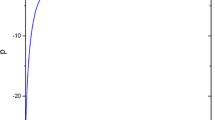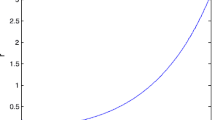Abstract
The Bianchi type-III cosmological model in \(f(R,T)\) gravity is investigated with the equation of state for wet dark fluid, i.e., \(P_{\text{WDF}} = \omega (P_{\text{WDF}} - \rho^{*} )\). Using volumetric and power-law expansion, we obtained the exact solution of the field equations. The various astrophysical phenomena, namely, the look-back time, proper distance, luminosity distance, angular diameter, jerk parameter, and cosmic snap with red shift and state-finder parameters, are also discussed.
Similar content being viewed by others
References
Adhav KS (2011) Statefinder diagnostic for variable modified chaplygin gas in Bianchi type-V universe. Astrophys Space Sci 335:611
Adhav KS et al (2011) Einstein–Rosen universe with wet dark fluid in general relativity. Int J Theor Phys 50:164
Adhav KS (2012) LRS Bianchi type-I cosmological model in f(R, T) theory of gravity. Astrophys Space Sci 339:365
Akarsu O, Kilinc CB (2010) Bianchi type-III models with anisotropic dark energy. Gen Relat Gravit 42:763
Armendariz-Picon C et al (2001) Essentials of k-essence. Phys Lett D 63:103510
Babicher E et al (2004) Dark energy cosmology with generalized linear equation of state. arXiv:astro-ph/0407190
Barreiro T et al (2000) Quintessence arising from exponential potentials. Phys Rev D 61:127301
Blake C et al (2011) The WiggleZ Dark Energy Survey: mapping the distance-red shift relation with baryon acoustic oscillations. Mon Not R Astron Soc 418:1707
Cai YF et al (2010) Quintom cosmology: theoretical implications and observations. Phys Rep 493:1
Caldwell RR (2002) A phantom menace? Cosmological consequences of a dark energy component with super negative equation of state. Phys Lett B 545:23
Caldwell RR et al (1998) Cosmological imprint of an energy component with general equation of state. Phys Rev Lett 80:1582
Carroll SM (2003) Can the dark energy equation-of-state parameter w be less than −1?. Phys Rev D 68:023509
Chaubey R, Shukla AK (2013) A new class of Bianchi cosmological models in f(R, T) gravity. Astrophys Space Sci 343:415
Chiba T et al (1997) Cosmology with x-matter. Mon Not R Astron Soc 289:L5
Cognola G et al (2008) Class of viable modified f(R) gravities describing inflation and the onset of accelerated expansion. Phys Rev D 77:046009
Copeland EJ et al (2006) Dynamics of dark energy. Int J Mod Phys D 15:1753
Copozziello S et al (2007) Reconstruction of the scalar–tensor Lagrangian from a ΛCDM background and Noether symmetry. Astropart Phys 0712:009
Copozziello S et al (2009) Noether symmetry approach in phantom quintessence cosmology. Phys Rev D 80:104030
De Felice A, Tsujikawa S (2010) f(R) theories. Living Rev Relat 13:3
Dvali G, Turner MS (2003) Dark energy as a modification of the Friedmann equation. arXiv:astro-ph/0301510
Dvali G et al (2000) 4D gravity on a brane in 5D Minkowski space. Phys Lett B 485:208
Eisenstein DJ et al (2005) Detection of the baryon acoustic peak in the large-scale correlation function of SDSS luminous red galaxies. Astrophys J 633:560
Elizalde E et al (2004) Late-time cosmology in a (phantom) scalar-tensor theory: dark energy and the cosmic speed-up. Phys Rev D 70:043539
Elizalde E et al (2011) Nonsingular exponential gravity: a simple theory for early- and late-time accelerated expansion. Phys Rev D 83:086006
Freese K (2003) Generalized cardassian expansion: a model in which the universe is flat, matter dominated, and accelerating. Nucl Phys (Proc Suppl) B 124:50
Freese K, Lewis M (2002) Cardassian expansion: a model in which the universe is flat, matter dominated, and accelerating. Phys Lett B 540:1
Frieman J et al (2008) Dark energy and the accelerating universe. Annu Rev Astron Astrophys 46:385
Gonzalez-Diaz PF (2004) k-essential phantom energy: doomsday around the corner? Phys Lett B 586:1
Harko T et al (2011) f(R, T) gravity. Phys Rev D 84:024020
Hayward ATJ (1967) Compressibility equations for liquids: a comparative study. Br J Appl Phys 18:965
Holman R, Naidu S (2005) Dark energy from a wet dark fluid. arXiv:astro-ph/0408102v3
Houndjo MJS (2012) Reconstruction of f(R, T) gravity describing matter dominated and accelerated phases. Int J Mod Phys D 21:1250003
Jamil M et al (2011) Noether symmetry approach in f(R)-tachyon model. Phys Lett B 702:315
Jamil M et al (2012) Resolution of dark matter problem in f(T) gravity. Eur Phys J C 72:2122
Knop RA et al (2003) New constraints on ΩM, ΩΛ, and w from an independent set of 11 high-redshift supernovae observed with the hubble space telescope. Astrophys J 598:102
Komatsu E et al (2011) Seven-year Wilkinson microwave anisotropy probe (WMAP) observations: cosmological interpretation. Astrophys J 192:18
Myrzakulov R (2012a) Cosmology of f(T) gravity and k-essence. Entropy 14:1627
Myrzakulov R (2012b) f(T) gravity and k-essence. Gen Relat Gravit. arXiv:1008.4486
Nojiri S, Odintsov SD (2006) Modified f(R) gravity consistent with realistic cosmology: from matter dominated epoch to dark energy universe. Phys Rev D 74:086005
Ostiriou TP, Faraoni V (2010) f(R) theories of gravity. Rev Mod Phys 82:451
Padmanabhan T (2003) Cosmological constant—the weight of the vacuum. Phys Rep 380:235
Peebles PJE, Ratra B (2003) The cosmological constant and dark energy. Rev Mod Phys 75:559
Percival WJ et al (2010) Baryon acoustic oscillations in the Sloan Digital Sky survey data release 7 galaxy samples. Mon Not R Astron Soc 401:2148
Perlmutter S et al (1998) Measurements of omega and lambda from 42 high redshift supernovae. Astrophys J 157:565
Perlmutter S et al (1999) Measurements of \(\varOmega\) and \(\varLambda\) from 42 high-red shift supernovae. Astrophys J 517:565
Rao VUM, Neellima D (2013) Non-static plane symmetric Zeldovich universe in a modified theory of gravity. Eur Phys J Plus 128:35
Ratra B, Peebles PJE (1998) Cosmological consequences of a rolling homogeneous scalar field. Phys Rev D 37:3406
Reddy DRK et al (2012a) Kaluza–Klein cosmological model in f(R, T) gravity. Int J Theor Phys 51:322
Reddy DRK et al (2012b) Bianchi type-III cosmological model in f(R, T) theory of gravity. Astrophys Space Sci 342:249
Reddy DRK et al (2013) Bianchi type-III dark energy model in f(R, T) gravity. Int J Theor Phys 52:239
Riess AG et al (1998) Observational evidence from supernovae for an accelerating universe and a cosmological constant. Astron J 116:1109
Riess AG et al (2004) Type Ia supernova discoveries at z > 1 from the hubble space telescope: evidence for past deceleration and constraints on dark energy evolution. Astrophys J 607:665
Sahni V (2004) Dark matter and dark energy. arXiv:astro-ph/0403324
Samanta GC (2013) Kantowski–Sachs universe filled with perfect fluid in f(R, T) theory of gravity. Int J Theor Phys 52:2647
Samanta GC, Dhala SN (2013) Universe filled with a binary mixture of perfect fluid and dark energy. Int J Theor Phys 52:1334
Samanta GC et al (2013) Five dimensional bulk viscous cosmological models with wet dark fluid in general relativity. Astrophys Space Sci 346:233
Samanta GC et al (2014) Universe described by dark energy in the form of wet dark fluid (WDF) in higher dimensional space time. Eur Phys J Plus 129:48
Setare MR, Jamil M (2011) Statefinder diagnostic and stability of modified gravity consistent with holographic and agegraphic dark energy. Gen Relat Gravit 43:293
Singh T, Chaubey R (2008) Bianchi type-I universe with wet dark fluid. Pramana J Phys 71:447
Tait PG (1888) The voyage of H.M.S. challenger, vol. 2. H.M.S.O., London, pp 1–73
Tonry JL et al (2003) Cosmological results from high-z supernovae. Astrophys J 594:1
Tsujikawa S (2010) Modified gravity models of dark energy. Lect Notes Phys 800:99
Author information
Authors and Affiliations
Corresponding author
Rights and permissions
About this article
Cite this article
Samanta, G.C., Bishi, B.K. Geometry of the Universe Described by Wet Dark Fluid in f(R, T) Theory of Gravity. Iran J Sci Technol Trans Sci 41, 223–230 (2017). https://doi.org/10.1007/s40995-017-0215-z
Received:
Accepted:
Published:
Issue Date:
DOI: https://doi.org/10.1007/s40995-017-0215-z




